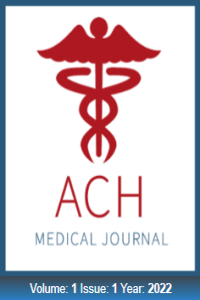Management of Non-Surgical Traumatic Facial Nerve Injuries
Management of Non-Surgical Traumatic Facial Nerve Injuries
Introductıon: Traumatic facial nerve injuries present a unique challenge to clinicians and surgeons because of the intricate facial nerve anatomy and profound impact on the psychological well-being and social interactions of patients. In this study, we aimed to shed light on the multifaceted nature of non-iatrogenic traumatic facial nerve injuries through an in-depth analysis of 12 distinctive cases. Methods: Between March 2019 and June 2022, at Ankara City Hospital and Akdeniz University Hospital, we conducted a retrospective analysis of 12 patients who presented with traumatic facial nerve injuries without surgery-related complications. To better understand the particularities of traumatic injuries to the facial nerve outside the context of surgical interventions, all cases selected for this study were of nonsurgical origin. Results: Twelve patients (eight males and four females) were included in the study. The average age of the patients was 29 years (range, 5–53 years). The causes of injury varied from dog bites in one patient, work-related injuries with a jigsaw in one patient, traffic accidents in two patients, sharp penetrating injuries in four patients, and temporal bone trauma in four patients. Five patients underwent a direct nerve repair. Three patients had nerve grafting. Three patients underwent reconstruction using a free functional gracilis flap. One patient underwent masseter nerve transfer. Considering the diverse treatment modalities applied and the subsequent outcomes observed, an algorithm was formulated. Conclusion: By sharing these experiences, we aspire to contribute a nuanced perspective to the existing body of knowledge on traumatic facial nerve injuries, further supporting clinical decision-making in such rare and challenging scenarios.
Keywords:
Facial paralysis, House–Brackmann scoring system Nerve repair, Traumatic injury of facial nerve,
___
- 1. Yang SH, Park H, Yoo DS, Joo W, Rhoton A. Microsurgical anatomy of the facial nerve. Clinical Anatomy. 2021 Jan 21;34(1):90–102.
- 2. Charters E, Coulson S. Oral competence following facial nerve paralysis: Functional and quality of life measures. Int J Speech Lang Pathol. 2021 Mar 4;23(2):113–23.
- 3. McElwee TJ, Poche JN, Sowder JC, Hetzler LT. Management of Acute Facial Nerve and Parotid Injuries. Facial Plastic Surgery. 2021 Aug 1;37(04):490–9.
- 4. Harris BN, Tollefson TT. Facial reanimation. Curr Opin Otolaryngol Head Neck Surg. 2015 Oct;23(5):399–406.
- 5. Carré F, Hervochon R, Lahlou G, Lastennet D, Gatignol P, Bernardeschi D, et al. Outcomes and prognostic factors of facial nerve repair: a retrospective comparative study of 31 patients and literature review. European Archives of Oto-Rhino-Laryngology. 2022 Feb 17;279(2):1091–7.
- 6. Boahene KO, Owusu J, Ishii L, Ishii M, Desai S, Kim I, et al. The Multivector Gracilis Free Functional Muscle Flap for Facial Reanimation. JAMA Facial Plast Surg. 2018 Jul;20(4):300–6.
- 7. Bayrak SB, Kriet JD, Humphrey CD. Masseteric to buccal branch nerve transfer. Curr Opin Otolaryngol Head Neck Surg. 2017 Aug;25(4):280–5.
- 8. House JW, Brackmann DE. Facial Nerve Grading System. Otolaryngology–Head and Neck Surgery. 1985 Apr 6;93(2):146–7.
- 9. Kim J, Moon IS, Shim DB, Lee WS. The Effect of Surgical Timing on Functional Outcomes of Traumatic Facial Nerve Paralysis. Journal of Trauma: Injury, Infection & Critical Care. 2010 pr;68(4):924–9.
- 10. Fliss E, Yanko R, Zaretski A, Tulchinsky R, Arad E, Kedar DJ, et al. Facial Nerve Repair following Acute Nerve Injury. Arch Plast Surg. 2022 Jul 30;49(04):501–9.
- 11. Frijters E, Hofer SOP, Mureau MAM.Long-Term Subjective and Objective Outcome After Primary Repair of Traumatic Facial Nerve Injuries. Ann Plast Surg. 2008 Aug;61(2):181–7.
- 12. Erkan ZA, Erkan SO, Tokucoglu F. Effectiveness of Surgical Treatment in Traumatic Facial Paralysis. Journal of Craniofacial Surgery. 2022 May;33(3):750–3.
- Başlangıç: 2022
- Yayıncı: Ankara Şehir Hastanesi
Sayıdaki Diğer Makaleler
Silent Pneumoperitoneum in a Major Burn Earthquake Survivor: Sigmoid Diverticular Perforation.
Merve AKIN, Tezcan AKIN, Ayse KARABAĞLI, Ahmet Çınar YASTI
Gökçe Naz KÜÇÜKBAŞ, Nazan AKGÜN KORUK
Management of Non-Surgical Traumatic Facial Nerve Injuries
Influences on Family Medicine Career Choice: Implications for Healthcare Development
Şeyma Handan DOĞAN, Tarık Eren YILMAZ, Adem ÖZKARA
Nuray YILMAZ ÇAKMAK, Gülay AYDIN, Kadriye KAHVECİ
Bergen LALELİ KOÇ, Betül AKGÜN AKTAŞ, Osman Onur ÖZKAVAK, Atakan TANACAN, Dilek SAHİN
